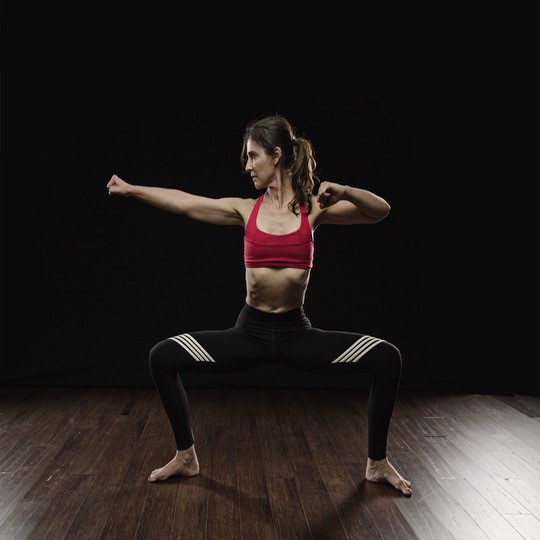By Lara Heimann, Yoga Pioneer and Physical Therapist
Yoga poses can be very helpful for realigning the pelvis so that the pelvis muscles, fascia, and other contents are more balanced . That balance given by the pelvic position impacts the neurological mapping of muscular activation (how pelvic muscles are summoned to fire), and also improves any nervous system dysfunction that leads to hypertonicity or hypotonicity.

Practice these poses and focus on the pelvic bowl being balanced as if it is suspended between the two legs in a level way.
1. Goddess Pose:
- Stand with your feet parallel and open your hips in external rotation, moving from your hips and not your feet (feet follow the movement of hips).
- Keep the spine lengthened and the pelvis balanced. Practice hugging the sit-bones (ischial tuberosities) together and lifting them up toward the upper pelvic bowl. Feel an energetic lift from the base of the pelvic floor and hold.
- Then, gently relax the upward lift and soften the pelvic floor.
- Repeat this and attempt to ramp up and down the activation of the pelvic floor muscles, adding an inhale as you lift up and an exhale as you release down.
2. Crescent Lunge:

- Stand with feet hip distance apart and step the right leg back, staying on the right toes.
- Bend the left knee and adjust the right knee to bend if the pelvis tilts forward. Feel the bowl of the pelvis stay level as you lift the arms up overhead.
- Breathe in and draw the contents of the pelvis up.
- As you exhale, stay strong in the whole pelvic complex without clenching.
- Repeat with right leg forward.
3. Bridge pose:
- Lie on your back and bring the feet on the floor with knees bent- you don’t want the feet too close or the pelvis will be inclined to tilt forward.
- Inhale and press the sacrum ( low part of the spine, above the tailbone). Exhale, lift the hips up without tipping the pelvis.
- Keep the low abdominals toned to support the pelvis and give assistance to the pelvic muscles and glutes.
4. Svasana:
- Lie on your back with legs extended or bolster support under the legs so the sacrum can be heavy and rooted on the floor.
- Fully relax all the muscles and lean into the floor.
- Feel the muscles inside the pelvic bowl relax to help the nervous system know when it’s time to relax.
Regular practice of these asanas will strengthen the pelvic floor muscle and improve blood circulation to the pelvic area.